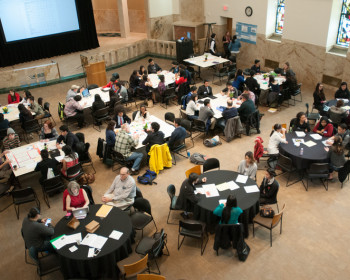Peddlers of Scrap: A liquidator, book scout and clothes picker dig through the rubble for saleable treasure
Thesis excerpt, by Christina Cooke, M.F.A.
Fabian Gordon does not claim to know — or care — about anything he sells. Like the surgical tables he bought for $10 a piece and sold for $700 each to a clandestine plastic surgery operation in Miami. “Did I test it?” he asks from behind the desk at his headquarters in an old brick storage building in Portland’s industrial east side. “Sure. I pressed the button, it went up and down. It did what I thought it was supposed to do. But what do I know? I don’t design the shit. I have no idea. The sticker on it said it was still in service. And that’s how I rep’d it,” he says, sounding matter-of-fact, almost belligerent. “We’re pretty straightforward about what we’re selling to people. I tell them here’s what it is, here’s where I got it.”
A large, jolly man with a shaved head and a dark goatee, Fabian runs Uncle Fabe’s Square Deals, a liquidation business that buys up the inventory of crashing businesses, as well as surplus stock from state and federal government agencies and resells it mostly online — on Amazon, eBay, Craigslist and various collector boards. “I am the place businesses go to die,” Fabian says. “People call it salvage, buy-and-sell, liquidation. I call it Last Man Standing. In the end, I’ll take everything.” And, he says, he’ll most likely sell it cheap. “Don’t come to me if you want to take something back or good customer service,” he says. Instead, he says, go to him if you want to buy something for $40 that’s worth $100. “My motto is good, fast and cheap — pick two. I try to be cheap, so it’s between good and fast.”
While Fabian’s m.o. makes sense from a business standpoint, I cringe at the thought of the table, or any other piece of medical equipment he has sold, malfunctioning in the middle of someone’s nose job. Fabian himself recognizes the shadiness of his Miami customers who fly in doctors from other countries on weekend tourist Visas to offer discount vanity services. They’re sketchy, he acknowledges. After all, he says, “they’re buying their stuff from me.”
Fabian and his counterparts in other fields — book scouts, clothes pickers, junk dealers — represent the last filter in place to catch objects on their way to the landfill. To make their livings, they track down items of interest, buy them for next to nothing and reinsert them into the economy in a different place, putting them in the hands of people who can use them. Fabian might take a bed from a VA hospital and resell it to the makers of a zombie movie [1], book scout Wayne Pernu may take a yellowing copy of Kerouac’s On the Road from an estate sale and put it in the hands of the buyers at Powell’s Books, and clothes picker Valentine Falcon may rescue a blouse from the ’70s from The Goodwill outlet and resell it at the vintage store she operates in Southeast Portland.
These three and other players in the second-hand economy operate by the same principles as those in the first-hand economy — their goal is to make money — but their success depends on their creativity and their scrappiness. They have to be able to re-vision things, to recognize an undervalued objects’ potential for something different, something more. And they have to be willing to spend hours digging through soon-to-be trash.
This afternoon, Fabian sits at his desk, buried under papers, envelopes, a yellow plastic fire fighting hat and a fake metal owl sculpture he purchased because he thought it looked Fascist. The tall white wall behind him is painted purple up to about eight feet, the height of an extended arm, in what appears to be a dashed-off attempt at interior décor. I sit across from him on the low, wide seat of a $1,200 hand-carved white oak chair that he bought for $40. At my back is a taxidermied bear rug with the nose partly chewed off, draped over a cardboard box. The rest of the office space is a colorless jumble of boxes, shelves, file cabinets and random equipment, including a centrifuge and a Ritter 107 multipurpose exam table with retractable stirrups and a scissor lift. From the white oak chair, many of the items strike me as highly technical, full of buttons and knobs whose purpose is beyond me. But as soon as Fabian begins telling their stories, sharing his conquests, they become infinitely more interesting.
“Over your right shoulder, see that big orange thing with the tubes that says Gearhart on it?” I turn and look up at a machine sitting on a high shelf. “That is designed for soil digestion. I can’t tell you what that means in English. Used, that’s a $17,000 piece of equipment. I paid $64 for it.
“It’s going to take me a while to get $17 grand for it,” he continues. “It would probably take me a while to get 10 grand — in fact, I’d probably take 5. But I paid $64, so it doesn’t really matter how long it takes.”
[1] He did, in fact; his merchandise plays a role in the Woody Harrelson, Jesse Eisenberg action comedy Zombieland.
More Continuing Education Stories
Center for Community Engagement is located in Rogers Hall on the Graduate Campus.
MSC: 85
email cce@lclark.edu
voice 503-768-6040
fax 503-768-6045
Director Matsya Siosal
Center for Community Engagement
Lewis & Clark
615 S. Palatine Hill Road MSC 85
Portland OR 97219

